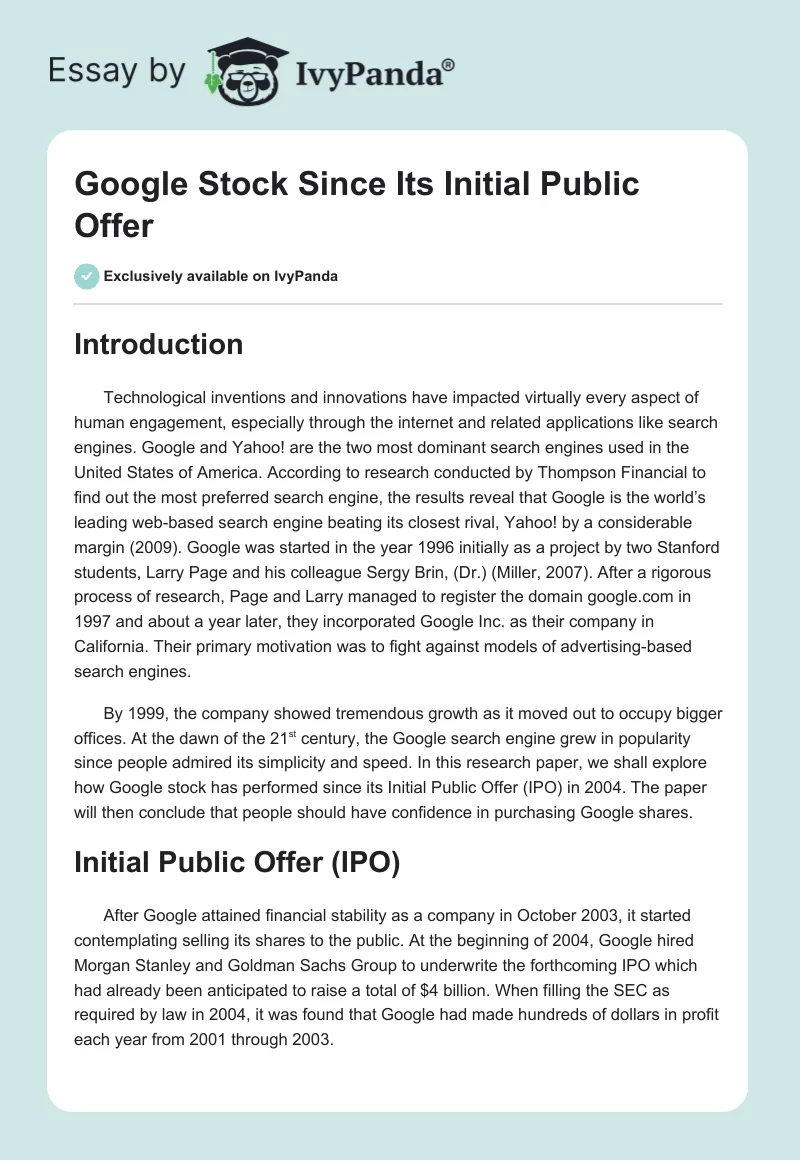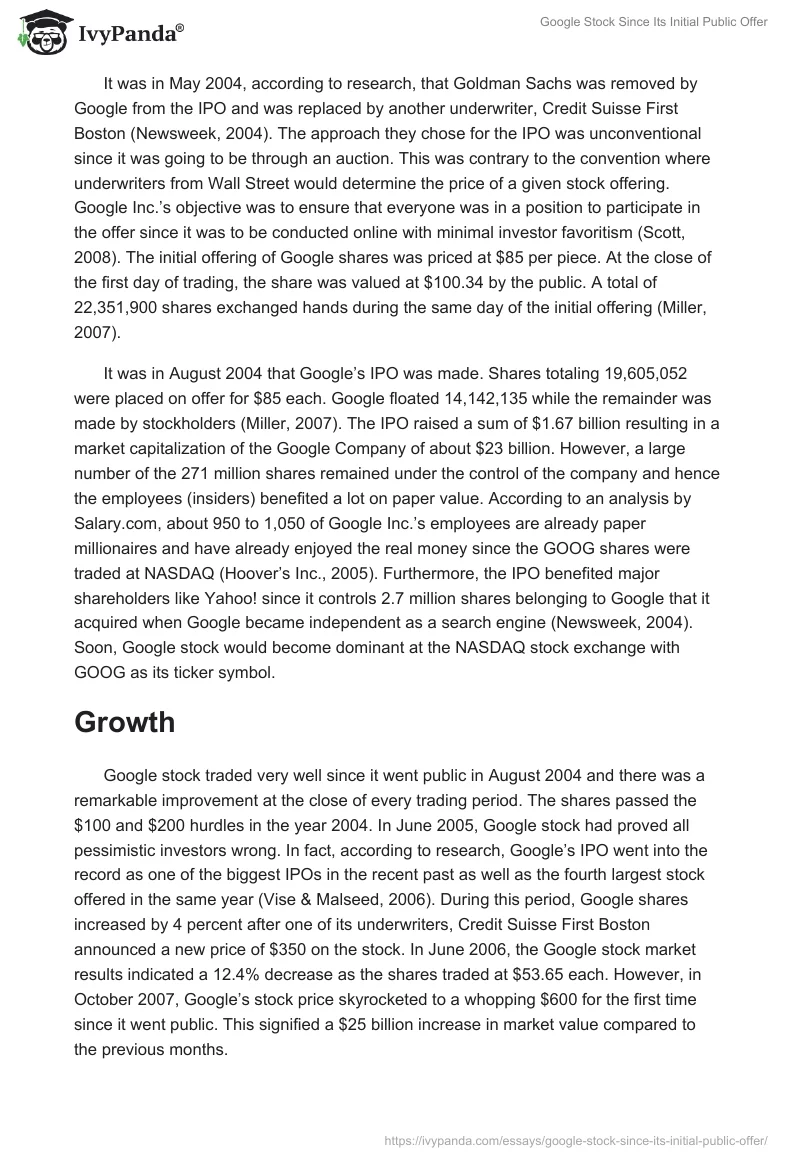Introduction
Technological inventions and innovations have impacted virtually every aspect of human engagement, especially through the internet and related applications like search engines. Google and Yahoo! are the two most dominant search engines used in the United States.
According to research conducted by Thompson Financial to find out the most preferred search engine, the results reveal that Google is the world’s leading web-based search engine beating its closest rival, Yahoo! by a considerable margin (2009). Google was started in the year 1996 initially as a project by two Stanford students, Larry Page and his colleague Sergy Brin, (Dr.) (Miller, 2007).
After a rigorous process of research, Page and Larry managed to register the domain google.com in 1997 and about a year later, they incorporated Google Inc. as their company in California. Their primary motivation was to fight against models of advertising-based search engines.
By 1999, the company showed tremendous growth as it moved out to occupy bigger offices. At the dawn of the 21st century, the Google search engine grew in popularity since people admired its simplicity and speed. In this research paper, we shall explore how Google stock has performed since its Initial Public Offer (IPO) in 2004. The paper will then conclude that people should have confidence in purchasing Google shares.
Initial Public Offer (IPO)
After Google attained financial stability as a company in October 2003, it started contemplating selling its shares to the public. At the beginning of 2004, Google hired Morgan Stanley and Goldman Sachs Group to underwrite the forthcoming IPO which had already been anticipated to raise a total of $4 billion. When filling the SEC as required by law in 2004, it was found that Google had made hundreds of dollars in profit each year from 2001 through 2003.
It was in May 2004, according to research, that Goldman Sachs was removed by Google from the IPO and was replaced by another underwriter, Credit Suisse First Boston (Newsweek, 2004). The approach they chose for the IPO was unconventional since it was going to be through an auction. This was contrary to the convention where underwriters from Wall Street would determine the price of a given stock offering.
Google Inc.’s objective was to ensure that everyone was in a position to participate in the offer since it was to be conducted online with minimal investor favoritism (Scott, 2008). The initial offering of Google shares was priced at $85 per piece. At the close of the first day of trading, the share was valued at $100.34 by the public. A total of 22,351,900 shares exchanged hands during the same day of the initial offering (Miller, 2007).
It was in August 2004 that Google’s IPO was made. Shares totaling 19,605,052 were placed on offer for $85 each. Google floated 14,142,135 while the remainder was made by stockholders (Miller, 2007). The IPO raised a sum of $1.67 billion resulting in a market capitalization of the Google Company of about $23 billion. However, a large number of the 271 million shares remained under the control of the company and hence the employees (insiders) benefited a lot on paper value.
According to an analysis by Salary.com, about 950 to 1,050 of Google Inc.’s employees are already paper millionaires and have already enjoyed the real money since the GOOG shares were traded at NASDAQ (Hoover’s Inc., 2005). Furthermore, the IPO benefited major shareholders like Yahoo! since it controls 2.7 million shares belonging to Google that it acquired when Google became independent as a search engine (Newsweek, 2004). Soon, Google stock would become dominant at the NASDAQ stock exchange with GOOG as its ticker symbol.
Growth
Google stock traded very well since it went public in August 2004 and there was a remarkable improvement at the close of every trading period. The shares passed the $100 and $200 hurdles in the year 2004. In June 2005, Google stock had proved all pessimistic investors wrong. In fact, according to research, Google’s IPO went into the record as one of the biggest IPOs in the recent past as well as the fourth largest stock offered in the same year (Vise & Malseed, 2006).
During this period, Google shares increased by 4 percent after one of its underwriters, Credit Suisse First Boston announced a new price of $350 on the stock. In June 2006, the Google stock market results indicated a 12.4% decrease as the shares traded at $53.65 each. However, in October 2007, Google’s stock price skyrocketed to a whopping $600 for the first time since it went public. This signified a $25 billion increase in market value compared to the previous months.
GOOG Price Historical trend
Historical consideration of Google Inc.’s trading trend will help depict how it has performed since it went public in August 2004 (Thompson Financial, 2009). In December 2004, the close price per share after being adjusted for dividends and splits stood at $192 which was slightly above double the initial price of $85. The rates then increased steadily and by July 2005, the stock traded at about $300 per share and at $287.76 after being adjusted for dividends and splits (Hoover’s Inc., 2005).
In December the same year, the close adjusted price was at a high of $414.86 which rose to $432.66 in January 2006. The closing stock prices fluctuated through the first half of the year and by the end of June, the price was at $419.33. In November 2006, a high of $484.81 was recorded at the NASDAQ making GOOG one of the most improved stocks with an average volume of 5.9 million shares traded (Vise & Malseed, 2006). The year 2007 seemed great for Google Inc. since the stock traded well and closed at a season-high of $501.50 having traded an average of 6.8 million shares.
The prices experienced ups and downs and by the end of June the shares traded at a stabilized adjusted price of $522.70 with a total number of about 6.3 million shares traded. The good fortunes of 2007 were yet to be experienced at the end of October when the stock price hit a record high of $707.00 having traded an average of 7.05 million shares. By the close of trading at the end of the same year, the price had dropped slightly to $691.48, albeit reducing the average volume of shares traded.
January 2008 was marked by a reduced price per share which stood at $564.30 with an overwhelming 8.2 million shares exchanging hands (Scott, 2008). By the end of May, the share price was $585.80 where about 5.13 million shares were traded. The price per share decreased drastically through the next half of 2008 to a low of $292.96 at the end of November, a period during which large volumes of shares (up to 9.3 million) were traded.
However, at the end of December, the share price stabilized at $307.65 and then rose exponentially through the following year, reaching a high of $619.94 in December with a volume of 1.99 million shares exchanging hands. At the beginning of business in January 2010, the share price started at $529.94 having a total volume of about 4.9 million shares being traded.
Analysts project that the share prices are expected to skyrocket to record high levels of about $710.21 at the end of July this year just like they did in October (Miller, 2007). According to Thomson Financial, the current average target price per share for Google’s stock among 30 analysts sampled stands at $656.87 (2009). Most analysts base their predictions on the rising 50 days moving average as well as the descending 200-day moving day average. This implies that investors can benefit from the current relatively lower rates of buying GOOG shares.
From the above analysis from a historical perspective, it is imperative to note that Google shares have increased more than seven times compared to their IPO price of $85. This trend has left Google Inc. with a market capitalization value of more than $187 billion which makes it worth larger than other prominent and established companies like Coca-Cola Co., Wal-Mart Stores Inc., IBM, and Hewlett-Packard C0.
Google Inc.’s general trend
A thorough analysis of the company’s balance sheet and income statements since 2004 when it sold its shares to the public reveals the companies general ability to withstand the market’s ups and downs. The company’s net worth (profitability) is obtained by subtracting total expenses from the revenues (sales). This is the formula for income statement. This analysis is done by comparing similar companies. Businesses that are running without substantial profit are doomed to fail in the marketplace. An analysis of Google’s profitability indicates that it has been consistently increasing in its net income (Vise & Malseed, 2006).
Further graphical analysis of the data, according to research, shows that the company has been growing on an exponential trend (Thompson Financial, 2009). This has been contributed mainly by the increase in the overall increase in the volume (revenue) from $6.1 billion in 2004 to a high of $10.6 billion within two years. Moreover, its variable costs have been decreasing significantly. A focus on the company’s cash flow indicates that Google has enough money in the bank to pay off all its financial obligations.
Also, it shows that the company has enough cash to invest just as it has been doing over the last five years of operation. We can therefore conclude that Google is depicting very strong economies of scale and a constant improvement of the business processes. This has ensured the provision of value to all of the company’s stakeholders.
Conclusion
The paper has provided a very in-depth analysis of Google Inc.’s performance, especially since it sold its shares to the public on August 19, 2004. It has focused on the GOOG stock performance at the NASDAQ stock exchange from August 2004 to January 2010 to establish a lifetime trend. A brief overview of the Google’s financial status and net worth has also been provided. We can therefore conclude that Google’s stock has a bright future especially in the 3rd Quarter of this year. This should be a major motivator for people to buy the shares at the moment if they hope to reap heavily within a span of 7 months.
References:
Hoover’s Inc. (2005). Hoover’s Manual of American business. Hoovers Inc.
Miller, M. (2007). Googlepedia: the origin of Google. Pearson Technology Group Newsweek (2004). Newsweek: Google Inc.’s IPO. Web.
Scott, V. (2008). Google. Greenwood Plc. Group.
Thompson Financial (2009). Google stock trend analysis. Journal of Stock Exchange Publications, New York.
Vise, D. A. & Malseed, M. (2006). Understanding the Google story. Delta Trade Paperbacks
Stock Trends Online. Google (GOOG) NASDAQ Historical Stock Trends Data. Web.


